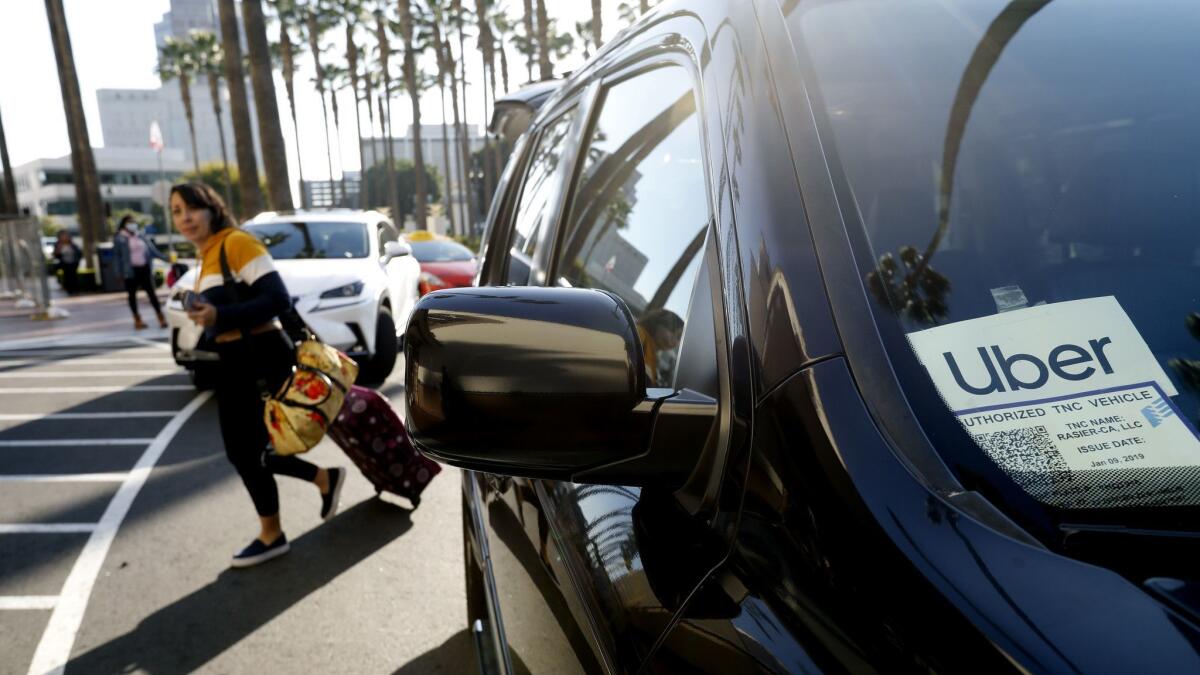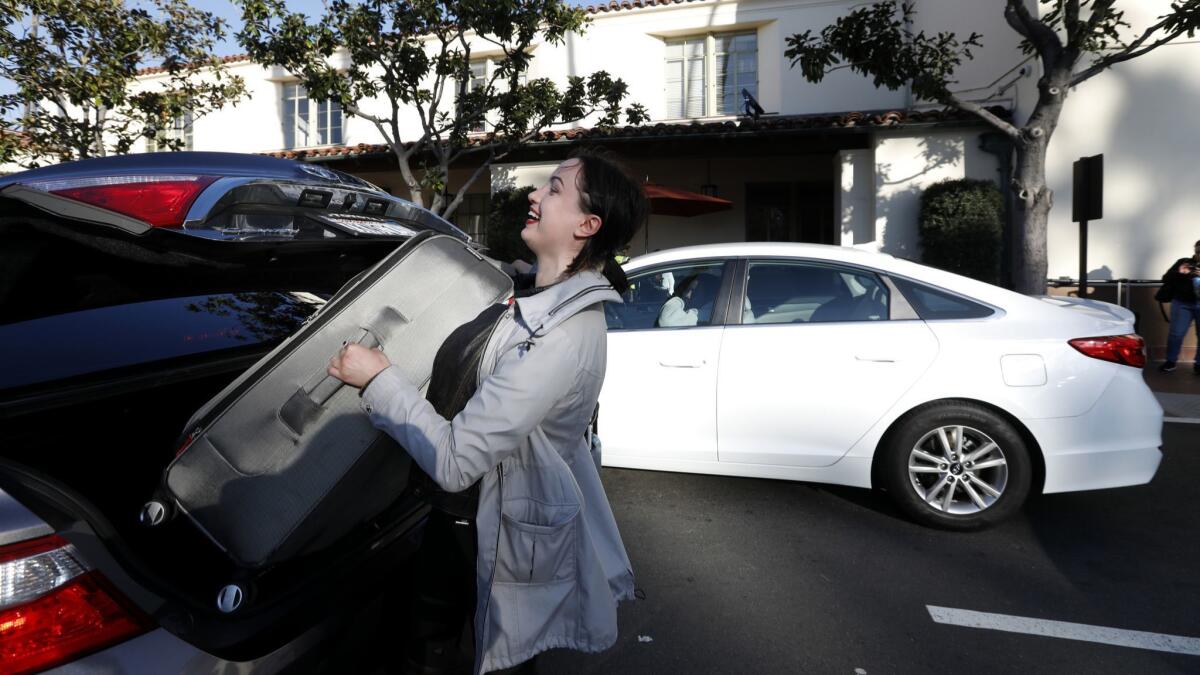Taxing Uber and Lyft rides is L.A. County’s latest idea to free up congested roads

- Share via
Transportation officials are considering a tax on Uber and Lyft rides in Los Angeles County, saying the Bay Area tech companies don’t pay their fair share to maintain public streets and exacerbate congestion in a traffic-choked region.
The ride-hailing fee is in the early stages of discussion at the Metropolitan Transportation Authority, along with more than a dozen other strategies to manage congestion and fund transportation projects before the 2028 Olympic Games.
Metro’s board of directors is scheduled to vote Thursday on whether to approve a study of the ride-hailing tax. The directors also will consider approving a study on congestion pricing, which would analyze the effects of converting more carpool lanes to toll lanes, taxing drivers on the number of miles they travel, or charging a fee for motorists to enter certain neighborhoods.
Once heralded as possible partners for transit agencies, Uber and Lyft have instead become fierce competition. A study of travel patterns in major U.S. cities last year found that 60% of customers would have gone by foot, bike or transit — or just stayed home — if the ride-hailing services had not been available.

The rise of Uber and Lyft is one of many factors contributing to L.A.’s plummeting transit ridership, which has fallen 20% in the last five years despite the billions of dollars spent on new rail lines. Ridership is now at its lowest level in more than a decade, driven by a shift to driving instead of using Metro’s sprawling bus network.
Uber and Lyft “are using public roads, and the profit is going to their companies,” Phil Washington, Metro’s chief executive, said at a recent meeting. Drivers spend a significant amount of time on the road with one or no passengers in their cars, he said, which has “no mobility benefit.”
If designed correctly, Metro’s tax on Uber and Lyft could nudge cost-conscious commuters to carpool or take public transit instead of riding alone with a driver, said Metro’s Chief Innovation Officer Joshua Schank. Discounts and penalties also could help Metro improve transit service for riders who use wheelchairs and live in low-income neighborhoods, he said.
The earliest such a tax could be assessed would be late next year, and it would require another vote by Metro directors. If all goes according to plan, Metro officials hope to start a congestion pricing pilot program at the same time.
Several major urban areas have imposed fees on ride-hailing services, including Chicago and Washington, D.C. New York City has two: an 8.875% sales tax added to each ride that benefits city and state coffers, and a fee that raises funds for the subway. (Passengers riding alone pay $2.75 — the price of a subway fare.)

As in those cities, riders in Southern California would probably see the ride-hailing tax added to their bills, rather than absorbed by the companies.
Uber and Lyft don’t share detailed ride data with local officials, so how much the tax could raise is unclear. But Metro’s rough estimates suggest a 20-cent fee on each trip could bring in $401 million over a decade, while a $2.75 fee could raise $5.5 billion.
In statements, Uber and Lyft said they support policies that apply to all types of traffic congestion, including personal cars and commercial vehicles. In New York, Uber has said it will spend $10 million to advocate for policies that would reduce single-occupancy driving, including congestion pricing.
But Uber would “caution against singling out specific services in ways that could limit choice and raise transportation costs,” spokesman Davis White said.
Lyft supports “comprehensive congestion pricing” as a way to reduce traffic, spokeswoman Kaelan Richards said. For riders, “cost and convenience are key factors when deciding to choose Lyft over their personal vehicles.”
Whether fees change rider behavior depends on their size and how they are applied, said Juan Matute, deputy director of UCLA’s Institute of Transportation Studies. A fee charged by the mile, as a flat rate or as a percentage of the cost of the total ride could each have a different effect.
A large fee could limit options for low-income riders, he said, while wealthier riders could pay and continue to use a ride-hailing service. A flat fee for all rides could limit short trips, and prompt Uber and Lyft to nudge customers toward scooters, bicycles or other devices, he said.
If directors approve the study on Thursday, Metro will examine how a fee would affect low-income riders, traffic and transit ridership, as well as assess how extensively the companies operate in Los Angeles, mimicking an analysis done by transportation officials in San Francisco in 2017.
In that study, researchers found that, in 2016, Uber and Lyft were responsible for 20% of the miles driven across the Bay Area city, and up to 26% during rush hour in the city’s most congested areas. The majority of the pick-ups and drop-offs — an average of 170,000 a day — were in dense, transit-rich neighborhoods, including SoMa and the Financial District.
“You can stand on the street corner and count the number of Ubers and Lyfts that are on the street, and see the problems they’re creating,” said Sunny Angulo, chief of staff to San Francisco Supervisor Aaron Peskin. “One of the ways we’re trying to mitigate that is by investing in our public infrastructure, and discouraging people from being really dependent on these services.”
Peskin is drafting a measure for the November election that would levy a 3.25% fee on rides with one passenger, and a 1.5% fee on shared rides. The tax would require support from two-thirds of voters and would raise an estimated $30 million a year for public transportation and pedestrian improvements, Angulo said.
Short of capping the number of vehicles allowed in San Francisco, which is prohibited by state law, it’s the best step the city can take, she said.
A bill signed into law last year grants San Francisco the authority to levy the per-ride tax, pending voter approval. In Los Angeles, Metro’s study would determine whether the agency needs to pursue similar legislation.
The push to fund more projects by the Summer Olympics, an initiative called “28 by ’28,” includes 20 projects that are slated to be finished within the decade, including the Wilshire subway extension to West Los Angeles and light-rail lines through South L.A. and Van Nuys.
Metro would need to find $26.2 billion to finish eight other projects by 2028. Those include several highway improvements, a rail line to Artesia and a Sepulveda Pass transit line.
To raise money, Metro also is considering a fee on bicycles, electric scooters, and other devices that can be rented per trip. Agency estimates show a $1 daily fee for each device could collect $580 million over a decade.
Some Metro directors, including Los Angeles Mayor Eric Garcetti, have begun advocating to disentangle the Olympics projects from the discussion over congestion pricing, saying the ideas would be more palatable to the public if they are framed as a way to manage traffic, rather than raise new revenue.
For more transportation news, follow @laura_nelson on Twitter.
More to Read
Sign up for Essential California
The most important California stories and recommendations in your inbox every morning.
You may occasionally receive promotional content from the Los Angeles Times.














